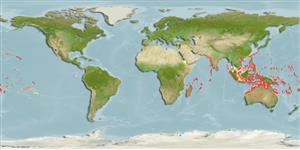Common names from other countries
>
Ophidiiformes (Cusk eels) >
Bythitidae (Livebearing brotulas)
Etymology: Brosmophyciops: Greek, brosomai, bibrosko = to eat up, to devour + Greek, phykis = a fish that lives among alga (Greek, phyke) + Greek, ops =appearance (Ref. 45335).
More on author: Schultz.
Environment: milieu / climate zone / depth range / distribution range
Ecologie
marien rifbewoner; diepte 6 - 54 m (Ref. 1602). Tropical; 30°N - 27°S
Indo-Pacific: Red Sea to Samoa and the Austral Islands, north to the Ryukyu Islands, south to Rowley Shoals. Recorded from the Gulf of Aqaba and the Gulf of Thailand (Ref. 34024).
Grootte / Gewicht / Leeftijd
Maturity: Lm ? range ? - ? cm
Max length : 7.5 cm TL mannelijk / geslacht onbekend; (Ref. 90102)
Korte beschrijving
Determinatiesleutels | Morfologie | Morfometrie
Dorsale stekels (totaal) : 0; Dorsale zachte stralen (totaal) : 78 - 84; Anale stekels: 0; Anale zachte stralen: 58 - 62. When alive, body coloration is brown with translucent orange fins and is covered in a thick granular mucus (Ref. 1602).
Lives in the interstices of lagoon or seaward reefs (Ref. 1602). Benthic (Ref. 75154). Body covered with heavy coating of mucus (Ref. 1602).
Levenscyclus en paargedrag
Maturities | Voortplanting | Spawnings | Egg(s) | Fecundities | Larven
Nielsen, J.G., D.M. Cohen, D.F. Markle and C.R. Robins, 1999. Ophidiiform fishes of the world (Order Ophidiiformes). An annotated and illustrated catalogue of pearlfishes, cusk-eels, brotulas and other ophidiiform fishes known to date. FAO Fish. Synop. 125(18):178p. Rome: FAO. (Ref. 34024)
Status op de Rode Lijst van het IUCN (Ref. 130435)
CITES (Ref. 128078)
Not Evaluated
Gevaar voor de mens
Harmless
Gebruik door de mens
Visserij: van geen belang
Tools
Speciale rapporten
Download XML
Internetbronnen
Estimates based on models
Preferred temperature (Ref.
115969): 25.3 - 28.9, mean 27.7 (based on 556 cells).
Fylogenetische diversiteitsindex (Ref.
82804): PD
50 = 1.0000 [Uniqueness, from 0.5 = low to 2.0 = high].
Bayesian length-weight: a=0.00457 (0.00179 - 0.01169), b=3.10 (2.87 - 3.33), in cm Total Length, based on LWR estimates for this (Sub)family-body shape (Ref.
93245).
Trofisch niveau (Ref.
69278): 3.3 ±0.5 se; based on size and trophs of closest relatives
Weerstandsvermogen (Ref.
120179): laag, minimale populatieverdubbelingstijd 4,5-14 jaar (Assuming Fec < 100).
Fishing Vulnerability (Ref.
59153): Low vulnerability (10 of 100).
